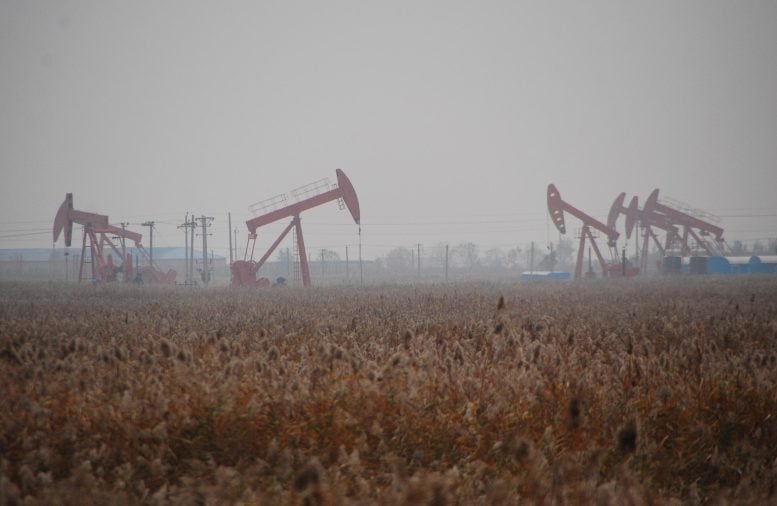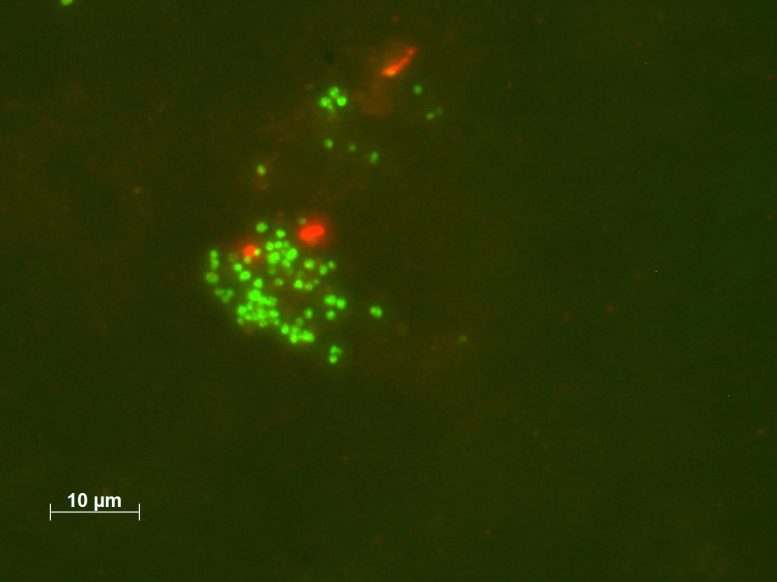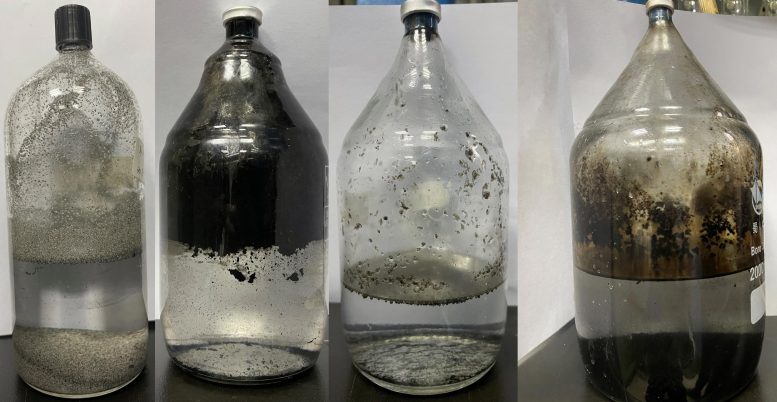
Scientists have managed to cultivate an archaeon capable of converting oil into methane.
Scientists have succeeded in cultivating an archaeon that converts oil into methane. They describe how the microbe achieves the transformation and that it prefers to eat rather bulky chunks of food.
Microorganisms can convert oil into natural gas, i.e. methane. Until recently, it was thought that this conversion was only possible through the cooperation of different organisms. In 2019, Rafael Laso-Pérez and Gunter Wegener from the Max Planck Institute for Marine Microbiology suggested that a special archaeon can do this all by itself, as indicated by their genome analyses. Now, in collaboration with a team from China, the researchers have succeeded in cultivating this “miracle microbe” in the laboratory. This enabled them to describe exactly how the microbe achieves the transformation. They also discovered that it prefers to eat rather bulky chunks of food.

In an oil field like this, Gunter Wegener and his colleagues found the microorganisms that now also live in their laboratory. Genetic information shows that they are widespread and even live in the deep sea. Credit: Yoshi Canopus
Underground oil deposits on land and in the sea are home to microorganisms that use the oil as a source of energy and food, converting it into methane. Until recently, it was thought that this conversion was only possible in a complicated teamwork between different organisms: certain bacteria and usually two archaeal partners. Now the researchers have managed to cultivate an archaeon called Methanoliparia from a settling tank of an oil production facility that handles this complex reaction all by itself.
Enzymes just in case
This “miracle microbe” breaks down oil into methane (CH4) and carbon dioxide (CO2). “Methanoliparia is a kind of hybrid creature that combines the properties of an oil degrader with those of a methanogen, i.e. a methane producer,” explains study author Gunter Wegener from the Max Planck Institute for Marine Microbiology and the MARUM – Center for Marine Environmental Sciences at the University of Bremen.

Image from the epifluorescence microscope: Methanoliparia cells (green) from the laboratory cultures. The oil droplet that the archaea colonized can be seen as a reddish glow. The red dots display rare bacteria in the culture. Credit: Rafael Laso-Pérez/Max Planck Institute for Marine Microbiology; from: Zhou et al., Nature, 2021
Now that the researchers have succeeded in cultivating these microorganisms in the laboratory, they were able to investigate the underlying processes in detail. They discovered that its genetic make-up gives Methanoliparia unique capabilities. “In its genes it carries the blueprints for enzymes that can activate and decompose various hydrocarbons. In addition, it also has the complete gear kit of a methane producer,” says Wegener.
New pathway of methanogenesis
In their laboratory cultures, the researchers offered the microbes various kinds of food and used a variety of different methods to keep a close eye on how Methanoliparia deal with it. What was particularly surprising to see was that this archaeon activated all the different hydrocarbons with one and the same enzyme. “So far, we have only cultivated archaea that live on short-chain hydrocarbons such as ethane or butane. Methanoliparia, on the other hand, prefers heavy oil with its long-chain compounds,” says co-author Rafael Laso-Pérez, who now works at Spain’s National Center for Biotechnology (CNB).
“Methanogenic microbes that use long-chain hydrocarbons directly – we didn’t know these existed until now. Even complicated hydrocarbons with ring-like or aromatic structures are not too bulky for Methanoliparia, at least if they are bound to at least one longer carbon chain. This means that besides our other exciting results we have also found a previously completely unknown pathway of methanogenesis.”

It doesn’t look like much, but it’s full of surprises: Bottles like these harbor the cultures of Methanoliparia. Credit: Lei Cheng
Detectable from the oil tank to the deep sea
The Methanoliparia cells cultured for the present study originate from one of China’s largest oil fields, the Shengli oil field. However, genetic analyses show that these microbes are distributed all over the world, even down to the deep sea. “Our results hold an entirely new understanding of oil exploitation in subsurface oil reservoirs. Both the wide distribution of these organisms and the potential industrial applications make this an exciting field of research in the coming years,” Wegener concludes.
Reference: “Non-syntrophic methanogenic hydrocarbon degradation by an archaeal species” by Zhuo Zhou, Cui-jing Zhang, Peng-fei Liu, Lin Fu, Rafael Laso-Pérez, Lu Yang, Li-ping Bai, Jiang Li, Min Yang, Jun-zhang Lin, Wei-dong Wang, Gunter Wegener, Meng Li and Lei Cheng, 22 December 2021, Nature.
DOI: 10.1038/s41586-021-04235-2









formatting error? 12/23 1:10
I apologize for the bad formatting. It is now fixed. There was extraneous HTML that messed up the formatting on some devises.
The CSS for this page is causing it to not display properly.
I apologize for the bad formatting. It is now fixed. There was extraneous HTML that messed up the formatting on some devises.
What’s the big deal? Humans convert oil into CO2 and water and use the energy to make their lives better.
I am a little confused…how did we get from “bad cattle industry” because cattle produce methane gas to “wow, let’s produce methane gas in a lab”. Something isn’t right here.
This sounds, terrible.
CO2 is bad enough for the atmosphere but methane is worse.
Do we really have to exploit this little critter and try to make as much of it as we can? I feel like I’ve seen how this movie ends.
If previous ice core gas analytics indicate the previous Ice Age was triggered at 400 parts per million carbon dioxide in the atmosphere, with a ten year onset, and where, back in 2013, May 9th, we surpassed it, then if the last two Polar Vortex Winters, combined with Atmospheric Rivers combining a potentially sudden and deep accumulation of widespread snow and ice in North America and Europe (reflectance), might we need this technology to provide as much natural gas as possible to heat our homes?
If true, then we would be already 8 years into that ten year onset stage.
I doubt the Earths tilt nor El Nino/La Nina would be as significant a set factors.
We must at least critically look into this possibility, and assist in discussion regarding the sealing of the natural gas leakages in our current natural gas infrastructures for this reason as well as considering the possible necessity of increasing (yes, as an environmentalist, increasing) the production of natural gas from depleted oil wells with this organism. (Even the increase in drilling of gas/oil wells should we be facing an onset of another Ice Age.)
Great news. Congratulations to the scientists. Do any of the oil eating microbes which were in news for some time, find larg scale adoption now?
Plot twist: the organism gets out in the wild, converts all of the oil into methane, turns Earth into a flaming ball of death.
James you moron, is anyone burning CO2? Nope, what does burned methane conver to moron?
no one likes you Hamilton.
https://scitechdaily.com/scientists-have-cultivated-a-miracle-microbe-that-converts-oil-into-methane/
Can someone reformat this to make it readable please
I apologize for the bad formatting. It is now fixed. There was extraneous HTML that messed up the formatting on some devises.
Is it so difficult for people to see that those microrganisms can help with degradeting oil stains in the ocean?
People are judging the research by it’s utility, but that’s not how science production works. For the first time we have found a organism with that abillity. It is very important, idependently of it’s implications for industry or enviroment or wathever. Further research will lead us to their utility.
I’m very confused as here in the USA we are looking at a new law at least here in California that we have to separate our organic food waste so it won’t end up in the landfill and create more methane so how is this discovery going to be of any use, as we have to much methane gass as it is. If we are trying to reduce methane then why would we want an enzyme that produces more, is that not like sleeping with the football team to remain a virgin?
The point is oil reserves are economically exploited up to nearly 45%, Being usual Just 20% avg of recoverable total volume of oil down there.
Microbes digesting oil and producing natural gas theoritically increases astronomically the total methane reserves worldwide. Bad news: hydrocarbons dependency might last longer. Good news is methane burns more efficient and Cleanly.
Sorry,Where you read “increases” you should read “can increase”. It is a long way to Go. It ALL depends on R&D.
WTF?!!
Why. Why do this. Global warming is already caused by greenhouse gases. There’s a microbe that transforms oil, which is already bad enough, to co2 and methane. AND THEY CALL IT “MIRACLE”. WHAT THE ACTUAL F***. Idiots. STOP. TRYING. To destroy THE F***ING PLANET💀☠😡🤬😤😞🙄🙄🙄🙄God help us all these so-called “*scientists* are IDIOTS.